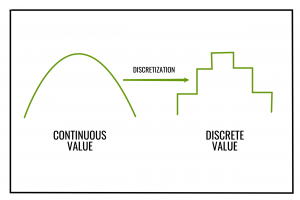毫升 |分箱或离散化
现实世界的数据往往是嘈杂的。噪声数据是其中包含大量额外无意义信息的数据,称为噪声。数据清理(或数据清理)例程试图消除噪音,同时识别数据中的异常值。
有以下三种数据平滑技术:
- Binning : Binning 方法通过查询其“邻域”(即它周围的值)来平滑排序的数据值。
- 回归:它使数据值符合函数。线性回归涉及找到适合两个属性(或变量)的“最佳”线,以便可以使用一个属性来预测另一个。
- 异常值分析:可以通过聚类检测异常值,例如,将相似值组织成组或“簇”。直观地,落在该组集之外的值可以被认为是异常值。
数据平滑的分箱方法 –
在这里,我们关注的是用于数据平滑的 Binning 方法。在这种方法中,首先对数据进行排序,然后将排序后的值分配到多个桶或箱中。当分箱方法参考值的邻域时,它们执行局部平滑。
基本上有两种分箱方法——
- 等宽(或距离)分箱:最简单的分箱方法是将变量的范围划分为 k 个等宽间隔。区间宽度就是变量的范围 [A, B] 除以 k,
w = (B-A) / k因此,第 i个区间范围将是
[A + (i-1)w, A + iw]其中 i = 1, 2, 3.....k
这种方法不能很好地处理倾斜的数据。 - 等深(或频率)分箱:在等频分箱中,我们将变量的范围 [A, B] 划分为包含(大约)相等数量点的区间;由于重复值,可能无法实现相同的频率。
如何对数据进行平滑处理?
执行平滑的方法有以下三种:
- 按 bin 均值平滑:在按 bin 均值进行平滑时,将 bin 中的每个值替换为 bin 的平均值。
- 按 bin 中值平滑:在此方法中,每个 bin 值都由其 bin 中值替换。
- 按 bin 边界平滑:在按 bin 边界进行平滑时,将给定 bin 中的最小值和最大值标识为 bin 边界。然后将每个 bin 值替换为最接近的边界值。
价格(美元)的排序数据:2、6、7、9、13、20、21、24、30
Partition using equal frequency approach:
Bin 1 : 2, 6, 7
Bin 2 : 9, 13, 20
Bin 3 : 21, 24, 30
Smoothing by bin mean :
Bin 1 : 5, 5, 5
Bin 2 : 14, 14, 14
Bin 3 : 25, 25, 25
Smoothing by bin median :
Bin 1 : 6, 6, 6
Bin 2 : 13, 13, 13
Bin 3 : 24, 24, 24
Smoothing by bin boundary :
Bin 1 : 2, 7, 7
Bin 2 : 9, 9, 20
Bin 3 : 21, 21, 30
分箱也可以用作离散化技术。这里离散化是指将连续属性、特征或变量转换或划分为离散或名义属性/特征/变量/区间的过程。
例如,属性值可以通过应用等宽或等频binning 来离散化,然后用 bin 均值或中值替换每个 bin 值,如分别用 bin 均值平滑或用 bin 中值平滑。然后可以将连续值转换为与其对应的 bin 的值相同的标称值或离散值。 
下面是Python的实现:
bin_mean
import numpy as np
from sklearn.linear_model import LinearRegression
from sklearn import linear_model
# import statsmodels.api as sm
import statistics
import math
from collections import OrderedDict
x =[]
print("enter the data")
x = list(map(float, input().split()))
print("enter the number of bins")
bi = int(input())
# X_dict will store the data in sorted order
X_dict = OrderedDict()
# x_old will store the original data
x_old ={}
# x_new will store the data after binning
x_new ={}
for i in range(len(x)):
X_dict[i]= x[i]
x_old[i]= x[i]
x_dict = sorted(X_dict.items(), key = lambda x: x[1])
# list of lists(bins)
binn =[]
# a variable to find the mean of each bin
avrg = 0
i = 0
k = 0
num_of_data_in_each_bin = int(math.ceil(len(x)/bi))
# performing binning
for g, h in X_dict.items():
if(ibin_median
import numpy as np
from sklearn.linear_model import LinearRegression
from sklearn import linear_model
# import statsmodels.api as sm
import statistics
import math
from collections import OrderedDict
x =[]
print("enter the data")
x = list(map(float, input().split()))
print("enter the number of bins")
bi = int(input())
# X_dict will store the data in sorted order
X_dict = OrderedDict()
# x_old will store the original data
x_old ={}
# x_new will store the data after binning
x_new ={}
for i in range(len(x)):
X_dict[i]= x[i]
x_old[i]= x[i]
x_dict = sorted(X_dict.items(), key = lambda x: x[1])
# list of lists(bins)
binn =[]
# a variable to find the mean of each bin
avrg =[]
i = 0
k = 0
num_of_data_in_each_bin = int(math.ceil(len(x)/bi))
# performing binning
for g, h in X_dict.items():
if(ibin_boundary
import numpy as np
from sklearn.linear_model import LinearRegression
from sklearn import linear_model
# import statsmodels.api as sm
import statistics
import math
from collections import OrderedDict
x =[]
print("enter the data")
x = list(map(float, input().split()))
print("enter the number of bins")
bi = int(input())
# X_dict will store the data in sorted order
X_dict = OrderedDict()
# x_old will store the original data
x_old ={}
# x_new will store the data after binning
x_new ={}
for i in range(len(x)):
X_dict[i]= x[i]
x_old[i]= x[i]
x_dict = sorted(X_dict.items(), key = lambda x: x[1])
# list of lists(bins)
binn =[]
# a variable to find the mean of each bin
avrg =[]
i = 0
k = 0
num_of_data_in_each_bin = int(math.ceil(len(x)/bi))
for g, h in X_dict.items():
if(i= abs(h-binn[j][1])):
x_new[g]= binn[j][1]
i = i + 1
else:
x_new[g]= binn[j][0]
i = i + 1
else:
i = 0
j = j + 1
if(abs(h-binn[j][0]) >= abs(h-binn[j][1])):
x_new[g]= binn[j][1]
else:
x_new[g]= binn[j][0]
i = i + 1
print("number of data in each bin")
print(math.ceil(len(x)/bi))
for i in range(0, len(x)):
print('index {2} old value {0} new value {1}'.format(x_old[i], x_new[i], i))
参考: https://en.wikipedia.org/wiki/Data_binning